to help the teacher, psychologist and educator
I hope, Dear Reader, that you and I are among those people who, no matter what they do, whatever they do, all the time unobtrusively develop their creative potential and just as unobtrusively help their friends and acquaintances do it.
Most often and most naturally, this process includes, willy-nilly, mothers raising their still small children and not dull, creative teachers working with schoolchildren in summer camps.
However, I want to draw your attention to the existence of some annoying pattern, characteristic of our Fatherland, which is stingy with a joke: Why is it that only mothers do all this “creative development” in our country and only in relation to their small children?
That's when our society gets rid of this pattern and begins to develop its creative potential "both young and old", then we will have a long-awaited "psychotherapeutic revolution", which I personally, for example, look forward to. And the result of this “revolution” will be that people on our streets will smile and demonstrate more relaxed behavior (not in the sense of lying on a park bench drunk), because they will be happy like children and without any poisonous dope ...
So, today I want to bring to your attention a few of my favorite intellectual games that are widely used in psychology both on their own and as a psychotherapeutic warm-up before any serious team activity.
Two words about mind games before we start.
Intellectual games are games that develop imagination, combinatorial functions of the intellect, flexibility, as well as associative thinking - they expand the associative field.
Intellectual games are all games with words; crossword puzzles, for example, can be attributed to this extensive class. However, we will start playing mobile body-oriented intellectual games (like the well-known mobile intellectual game for the smallest - "edible-inedible").
Intellectual game "Cicero's Algorithm"
This word game is the simplest and is great for the role of the "first warm-up game" before any serious creative group work.
A group of players sits in a circle (a prerequisite is the condition of the so-called "round table", that is, placing the playing group in a circle that ensures the equality of all participants and thus their psychological comfort).
Sitting comfortably in a circle, the group receives the task: to tell absolutely any story, relying on the famous "Cicero's Algorithm", that is, on a series of sequential questions:
- What for?
- When?
Attention!
You can also use Cicero's algorithm to develop your own (and others') "writing" abilities. (Actually, this is exactly what it was invented for!) If you have never written stories in your life, sit down and work with Cicero's Algorithm - you will see, a masterpiece will suddenly come out from under your pen!
Play this intellectual game in several rounds. After a few rounds of the game, after a series of unsuccessful and insignificant remarks, the players will begin to "create", and then start writing down what the participants in the game say - such "fruits" of the collective drive cannot be neglected!
Intellectual game "Chain of associations"
This intellectual game is played with the ball, sitting on chairs. Outside the game are the Host and his Assistant - they evaluate the correctness of the game. To select an Assistant, the players draw lots. An assistant in this game is needed only so that the game is not or does not seem too authoritarian, does not resemble a “school”, due to the fact that one person “judges” in it, often an older one.
Sitting in a circle, the players take turns sending each other a ball, shouting out any word that comes to mind. The one to whom the ball was sent must AUTOMATICALLY answer the association that came to his mind and immediately send the ball to another.
This game DOES NOT:
- create pauses,
- break the chain of associations.
If this rule is not observed, the player is removed by the Host and his Assistant from the game.
The game continues until there is only one person left - the Winner.
During the elimination of players, the eliminated players join the jury and get the right, together with the jury, to shout “Pass!” or "Does not count!".
Attention:
In this intellectual game, conflicts and subsequent proceedings are possible. This is possible because some people give out stereotypical associations, and some (by the way, the most creative people) give very complex associations, which are sometimes perceived as a violation of the rules of the game, as a break in that very “chain”.
For example: if someone shouts “cream” or “Allergy” or “June” or “cottage” to the word “Strawberry”, then this does not raise questions from anyone.
But if I shout out “self-tanning” to the word “Strawberry”, then this, of course, requires explanation.
For this, the game is introduced
additional rule
Having heard a “controversial” association, the Host has the right to throw a remark: "Explain!"
The player who gave the disputed association must, in a short time, clearly and concisely explain-convince the jury, clarify his association to the group. Uncover your thoughts. If he fails, he still leaves.
A non-standard-minded player, therefore, solves the “problems of increased complexity” assigned to him in this game, which is both fair and useful for the course of the entire game, since soon (under the influence of a tendency to imitate) the whole group will move to the level of a game of increased complexity - shouting complex associations with concise and intelligible explanations.
Example
- Strawberry!
- Self-tanning!
- Explain!
- "Strawberry" is a photo of naked beauties. Nude beauties use self-tanner.
Intellectual game "The sea is worried"
It's pretty tricky but incredible interesting game, with elements of body-oriented therapy. I would recommend playing her "third" in a row. It requires preliminary warm-ups, which can be used in the previous two games.
In this intellectual game, short-term memory and speed of bodily reactions are actively trained - at the same time.
The chairs are arranged in a row (as in a theater), the players occupy the chairs. The host stands in front of the players, facing them. The "base" is selected in the room, some remote from the main game space the place where the Host will take the players.
Start. "The words".
Each player comes up with one word (noun) and loudly calls his word aloud - to the Leader.
The last player in the row calls out their intended word and becomes the Storyteller.
Continuation. "The Storyteller's Tale".
The last player to become a Storyteller begins to spin a tall tale - that is, to tell a coherent story. In this story, he must insert in turn all the words that sounded in the game.
As soon as “his word” sounds, the player who uttered this word rises from his seat and walks, holding the Leader’s hand to the “base” - that is, away from the main space of the game.
So, all players line up as the Leader in the "Chain-queue".
Last chord. "Ocean is shaking!"
After going through all the words that have sounded, including his own word, the Narrator LOGICALLY completes his fictional story with the phrase: “The sea is worried!”
As soon as this phrase sounds, all the players assigned to the base must rush to their chairs in order to have time to take their places, because the Leader runs with them, trying to take the place of the player who was late to his chair.
The one whose chair is taken by the Leader becomes the Leader in the next round of the game.
Attention:
The main intrigue in this game is created by the Narrator. He must confuse listeners with his story: at first, make him wait a long time " keyword”, and then give out several words in a row, thereby alternating agonizing expectation and joyful fuss.
Intellectual game "Theater of Abbreviations"
This game is relatively easy, but it requires “acting skills” from its participants, which means that everyone is relaxed, the cohesion of the group as a whole - that is, it requires a preliminary warm-up.
The driver goes out the door. The players, after consulting, come up with a word together.
The Leader will have to guess this word when he returns. The letters that make up this word are distributed among the players.
Each letter must correspond to a certain type of behavior, character trait, social type. It is better if you play one thing, for example, only traits or only types or professions of people
Z - envy,
W - greed
Oh - mischief
When the Host returns to the room, the participants in the game present pantomimes to him. The driver must guess what they are trying to show him, and from the first letters of the guessed words, add and unravel the WORD conceived at the beginning of the game.
Intellectual game "Line from a song" / "Line from a poem"
This game is a little more difficult, but also more interesting than the previous one.
The host goes out the door, and the participants together think of a line from a song or poem and distribute the words to the honey.
The leader enters the room. The host must prepare (or spontaneously come up with during the game) questions to the participants in the game - one question for each player.
The moderator asks a question.
The player to whom the question is asked must answer the question in such a way that the answer sounds like the word from the intended line, which he got by lot.
Conceived line: "Children, get ready for school, the cockerel sang a long time ago."
Masha (the word CHILDREN was drawn by lot)
Leading: Masha, how much will it be twice two?
Masha: Well, even children and blondes know this: twice two makes four.
(Let the facilitator guess what word is hidden in this statement).
If you manage to play all five of the intellectual games I have proposed in the near future, you will cope with all the other life difficulties.
Start by organizing a holiday, a holiday that benefits people...
“If we drop seeds on solid ground, the chances that they will take root and grow into healthy plants are slim. However, if we plow and cultivate the soil - we loosen it well and break up the clods - then it is quite possible that in the loose earth most of our seeds will germinate ...
In the same way, if we start out cold, with a serious, tense facilitator posing questions and concerns to a shackled, conservative group, then the chances of generating productive ideas are minimal.
Warm up exercises
Help your brainstormers relax and talk by working their minds with these warm-up exercises. The group will become more receptive to new ideas, which will allow them to sprout in the minds of the participants.Children's drawings. Ask each participant to bring their children's drawings. Hang them on the wall without signing. Ask participants to guess the author of each drawing.
Symbol. Ask participants to draw a personal symbol that represents their point of view on creativity. It can be anything - an eagle, a compass, a brush, a moon, etc. Then each participant shows their symbol and explains how or why it represents their point of view.
Corporate symbol. Ask participants to choose an animal, bird, insect, or fish as their corporate symbol. Let them justify their choice. Ask if this creature embodies both the strong and the weak sides corporations.
"You're fired". Sometimes it is necessary to turn on the fire alarm to bring people out of their complacency. At the beginning of the meeting, ask the participants to imagine that they have been fired. Then ask them to apply for the job again. This should shake them up and make them think about their knowledge and skills, and most importantly, how to improve them. Or print an imaginary future newspaper that declares your company bankrupt. Then ask the participants to present the reason why the company went bankrupt. The element of shock encourages us to see, hear and experience our world in a new way.
Everyone is a consultant. Ask each person to clean slate paper wrote the current problem related to work. For example: “How can I better cooperate with store employees to fulfill orders on time?” or “How can we respond to a competitor’s low prices and discounts? After giving a few minutes to write down the problems, ask everyone to pass their problem on to the person on the right. This person reads the problem they just received and succinctly writes down their answers. Sixty seconds are allotted for each sheet. Continue this process until each person has received their sheet back. Then read and discuss the written ideas.
Observation of others. When using this approach, new thoughts and solutions come from looking for ideas in extraneous areas. As a preliminary exercise for a meeting on the strategy and tactics of selling luxury jewelry boxes, sales and marketing workers were sent to observe marketing and sales activities in outside businesses. retail such as shops fashion clothes, software, restaurants fast food and bookstores. They returned with long lists of ideas and suggestions to apply to their company.
Accepting the role of the Client. When using this approach, people are trying to learn what it means to be in a different role. For example, a real estate agent sent his salespeople to a car dealership to improve their sales skills. While posing as customers, they went through the entire sales process, recording the specific behaviors, words, and actions of salespeople that significantly influenced their attitude as "buyers." On the general meeting they shared experiences and discussed ways to develop their own sales skills. This experience made salespeople see that it's one thing to talk about being able to step into a buyer's shoes, and quite another to actually do it.
Space being. Invite the group to imagine a creature living on another planet with a different atmosphere in a distant solar system. Ask them to draw this imaginary creature. Then have the group show their drawings.
You'll find that most people draw creatures that resemble earth creatures, even though we're free to come up with whatever we want.. Namely, creatures with organs of sight, hearing and smell, as well as arms and legs with bilateral symmetry. Instead of creating something unique and unpredictable, most people create creatures that have a lot in common with each other and with the features of typical terrestrial animals.
There is no reason why animals on other planets should resemble terrestrial animals. People drawing space creatures could use any existing knowledge base (such as geological formations, tumbleweeds, or clouds) to get an idea of the general shape of a space creature, and each person could come up with something special and new. But most people do not do this, and therefore, in their drawings, creatures are obtained that have the properties of earthly creatures.
This group exercise demonstrates a phenomenon called structured imagination. Structured imagination is related to the fact that even when we use our imagination to generate new ideas, these ideas are structured in a very predictable way according to existing concepts, categories and stereotypes. This is true whether we are talking about inventors, artists, writers, scientists, designers, business people, or people's everyday dreams of a better life.
Walking in someone else's shoes. Sit the participants around the tables in groups of six to ten people and ask everyone to take off their shoes. Then talk for a few minutes about how the participants feel as they sit at the table in a serious business meeting without shoes. Discuss the fact that it's natural to go barefoot at home and on vacation, but it's not usually done in a business setting. Then ask participants to try a few different activities:
1. Ask them to swap shoes - actually wear someone else's shoes. Ask them to try to bring about significant change; for example, let the men wear women's shoes. Discuss how they feel about it. Talk about and how it feels to break them slightly.
2. Then ask them to put their shoes on the table in front of them. Let everyone sit and look at all these shoes for a while. Watch for signs of nervousness. Usually participants experience this as something unnatural, uncomfortable and anti-social. Talk about how they feel when someone's shoes are on the table in front of them. Talk about how participants deal with feeling uncomfortable, usually by trying to ease it. But point out that improvement implies change, and change almost always brings discomfort. An innovative change must actually go beyond the generally accepted framework, which causes even more discomfort, etc.
3. Now announce a competition where the team that builds the tallest shoe structure will win a big contract. The winner is determined by measuring the distance from the surface of the table to the highest point of any shoe. Do not discuss the competition in detail; just tell the participants what they need to do in four minutes and say, "Let's start." One solution might be to have the tallest person in the group stand on the table and place one shoe on their head. Or you can come up with a rule that all shoes should be in a chain, touching each other, like an electrical circuit.
Observe what the participants are doing during this exercise so that you can discuss it in detail later. You will be amazed at the creative solutions offered by the groups. Note how quickly or slowly the problem was solved in different groups. Note the emergence of informal leaders. Determine the cycles of construction, demolition and reconstruction, etc. Just watch. You will have a lot of topics for discussion.
Completing a task with shoes strengthens the team.
The participants did not know that they would be asked to build a structure out of shoes, but they were gradually prepared for this idea. This can be a good strategy when implementing innovative ideas.
The greatest inconvenience is caused by what we think too much about; just start acting, and the feeling of discomfort will be significantly reduced.
It's not stealing when you get an idea from watching another team. It is learning from the experience of others while improving the business.
When looking for solutions, it is often helpful to use the most unexpected items. (For example, I once saw a group build what looked like a chimney from workshop folders, and then fill the chimney with shoes on top. There's always someone taking off their belt to tie something to something, etc.) e.)
Self-presentation. Getting the participants to know each other. Development of group cohesion. Removal of emotional tension, tightness. Formation of installation on mutual understanding. Improvement of communicative culture. Development of cohesive action skills.
1.1. Exercise "Princess, dragon and samurai"
Aim A well-executed exercise will greatly invigorate and amuse the participants. Group size 8-14 people Time 10-15 minutes Instructions Let's divide into two equal in number of team members. I suggest you play the game "The Princess and the Samurai". This game is similar to the children's toy Rock-Paper-Scissors. Remember this game? OK. Only this game is a team game. This means that team members will have time to agree on which figure they will show. After you agree, the teams line up in two lines against each other and at my command, you simultaneously show the selected figures. We will have three figures: a princess, a samurai and a dragon. Princess defeats Samurai, Dragon Samurai, Dragon Princess. How to show figures? Samurai. How will we show it? The usual image of a samurai is a sword, he is aggressive and shouts "banzai". Let's try to show a samurai: everyone has a sword in their hand, step forward, strike with a sword and shout “banzai”! On the count of three or four! The Dragon. How can we show the dragon? He is bigger and scarier, and he also has flames from his mouth. Let's try to show the dragon on my command: step forward, claw hands and growl - rrrrrr. A princess. "Well, we'll have a 'warm princess'. Let's try it: a chorus girl, with a hem in her hands, with her feet like in a variety show and singing "la-la-la". We figured out the figures, now each team has 30 seconds to discuss their the first move, i.e. which piece you will show.Try to discuss so that the other team does not hear you.The game will be played up to three wins.
1.2. Exercise "Ha-ha-ha"
Purpose Fun, emotional warm-up. Helps lift your spirits. Group size 6-14 people Time 5-10 minutes Course of the exercise Everyone lies down with their head on the stomach of another participant, thus forming a long chain. The first player says: "Ha", the second: "Ha ha", etc. The game restarts if someone laughs.
1.3. Exercise "Catch up with the pig"
Purpose Warming up helps to relieve unnecessary tension. Group size 6-14 people Time 10 minutes Course of the exercise All participants stand facing in a circle. It is proposed to imagine that a small, pink pig is running around in a circle, which grunts all the time. The task of the players is to catch the pig. And they do it in the following way: at the command of the host, the sound “oink” is transmitted in a circle from one participant to another, while the time is recorded on the stopwatch. The game is played several times, each time the rate of passage of the sound "oink" in a circle increases.
1.4. Exercise "Pupsik"
The purpose of the warm-up is somewhat provocative in content. But this provocation helps to cheer up and cheer up the participants. Group size 6-14 people Time 5 minutes Instructions We will now conduct one exercise with you, but you owe me and your colleagues that the conditions of the game will be fulfilled to the end. Get the baby doll. Let's turn on the imagination and imagine that we are a collection of ancient magi or sorcerers. A new man has been born, and we must endow him with something special. We will pass this child in a circle from hand to hand. When the child is in your hands, you must reward him with some gift. For example, say: I reward you with a good heart. In this case, you need to kiss the baby doll in the heart. We launch the baby in a circle. And now, for your wishes to come true, you must kiss your neighbor on the right where you kissed the baby...
1.5. Exercise "Who is this?"
Purpose Fun workout. Allows people to be creative and causes a lot of positive emotions. Group size Any Time 15 minutes Instructions The purpose of the exercise we are going to do is to have fun and thus cheer us up and prepare us for further training. Take each piece of paper and draw a head on top - a person, an animal, a bird. Bend the sheet so that the drawn is not visible only the tip of the neck. And pass the drawing to a neighbor. Each participant in the game had a new sheet with an image that he had not seen. Everyone draws the upper part of the torso, "hides" the drawing again and passes it on to a neighbor to draw the limbs on the new sheet received. Now expand all the drawings and see what creatures are depicted on them.

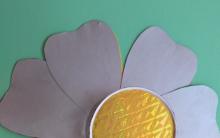

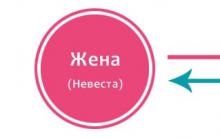
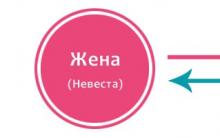
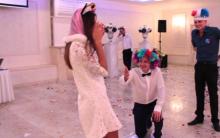
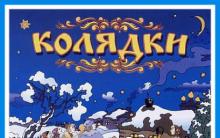




How to make a bird costume with your own hands Carnival bird costume
Scenario for 25 years girl cool houses
Examples of serious nominations for rewarding employees
The script for the anniversary of the girl (young woman) "A star named ...
Comic nominations for a corporate party